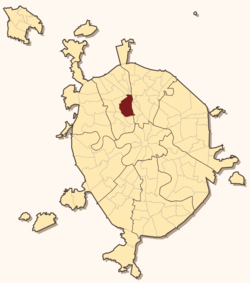Timiryazevsky District
| Timiryazevsky District Тимирязевский район (Russian) | |
|---|---|
 Location of Timiryazevsky District on the map of Moscow | |
|
Timiryazev Agricultural Academy, Timiryazevsky District | |
.png) |
.png) |
|
| |
| Location | |
| Country | Russia |
| Federal subject | Moscow |
| Statistics | |
| Area | 10.43 km2 (4.03 sq mi)[1] |
| Population (2017 est.) | 82,800 inhabitants[1] |
| Density | 7,938.64/km2 (20,561.0/sq mi)[2] |
| Time zone | MSK (UTC+03:00)[3] |
| Official website | |
| Timiryazevsky District on WikiCommons | |
Timiryazevsky District (Russian: Тимирязевский райо́н) is an administrative district (raion) of Northern Administrative Okrug, and one of the 125 raions of Moscow, Russia.[4] The district is known for its public parks - Timiryazavsky Park and the Dubki Park - and the Timiryazev Agricultural Academy. The total area of the district is 10.43 square kilometers (4.03 sq mi).[1] Population: 82,800 (2017 est.)
History
Timiryazavsky Park is near the site of the Petrovsko-Razumovskoye estate. The estate was the ancestral home of the Shuysky family, sold to the Naryshkin family in 1676 and passed to Peter the Great in 1705 and became known as 'Petrovsky'.[5] It was owned by the Razumovsky Family in the 18th and 19th centuries.[6] On the grounds was built the Razumovsky Palace, the architect of which was Nicholas Benois. 1n 1861, the palace became the home of the Petrovsky Agricultural and Forestry Academy, today the Timiryazev Agricultural Academy.[5]
The academy, and the district, are named for Kliment Timiryazev, a botanist who established a faculty and laboratory of vegetable physiology at the Petrovsky Academy.[5] The academy houses several museums open to the public, including what the district government calls 'the only horse-breeding museum in the world'.[7]
See also
References
Notes
- 1 2 3 "General Information" (in Russian). Timiryazevsky District. Retrieved February 5, 2018.
- ↑ The value of density was calculated automatically by dividing the 2017 population estimate by the area specified in the infobox. Please note that this value is only approximate as the area specified in the infobox does not necessarily correspond to the area of the entity proper or is reported for the same year as the population.
- ↑ Правительство Российской Федерации. Федеральный закон №107-ФЗ от 3 июня 2011 г. «Об исчислении времени», в ред. Федерального закона №271-ФЗ от 03 июля 2016 г. «О внесении изменений в Федеральный закон "Об исчислении времени"». Вступил в силу по истечении шестидесяти дней после дня официального опубликования (6 августа 2011 г.). Опубликован: "Российская газета", №120, 6 июня 2011 г. (Government of the Russian Federation. Federal Law #107-FZ of June 31, 2011 On Calculating Time, as amended by the Federal Law #271-FZ of July 03, 2016 On Amending Federal Law "On Calculating Time". Effective as of after sixty days following the day of the official publication.).
- ↑ Государственный комитет Российской Федерации по статистике. Комитет Российской Федерации по стандартизации, метрологии и сертификации. №ОК 019-95 1 января 1997 г. «Общероссийский классификатор объектов административно-территориального деления. Код 45», в ред. изменения №278/2015 от 1 января 2016 г.. (State Statistics Committee of the Russian Federation. Committee of the Russian Federation on Standardization, Metrology, and Certification. #OK 019-95 January 1, 1997 Russian Classification of Objects of Administrative Division . Code 45, as amended by the Amendment #278/2015 of January 1, 2016. ).
- 1 2 3 "A History of Russian Forestry and Its Leaders". DIANE Publishing. Retrieved February 22, 2018.
- ↑ "Timiryazevsky Public Park". Moscow Info. Retrieved February 22, 2018.
- ↑ "History of the District" (in Russian). District of Timiryazevsky. Retrieved February 22, 2018.
External links
- [Timiryazevsky Public Park http://www.moscow.info/parks/timiryazevsky-park.aspx]
Coordinates: 55°49′09″N 37°33′31″E / 55.81917°N 37.55861°E
